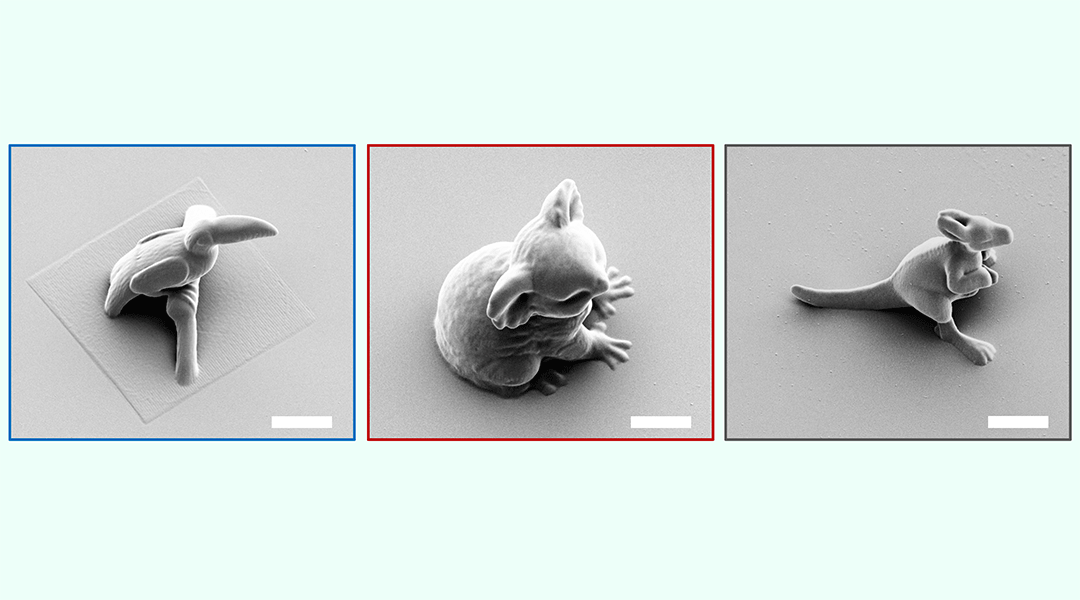Much of the energy invested in technological advances aims to synthetically reproduce (often with relatively clumsy implements) the elegant complexity of nature.
Diverse structures arise in nature through the defined assembly of modular building blocks — think of the genetic code of DNA, or the variety of protein structures arising from tiny variations in amino acid sequence.
In a new approach to microscale 3D printing, researchers precisely engineer their inks’ molecular sequence, affording control of the printed product’s fundamental properties. This opens the door for greater precision for engineering materials for use in microrobotics, optics, and as biomedical devices.
Inspired by nature
“We always think nature is the best inspiration,” said Eva Blasco, professor at Heidelberg University and senior author of the study in Small. “And if you think about polymers in nature, they are always very well defined.”
This definition (vis-à-vis monomer sequence) allows for the astonishing diversity of function present in natural polymeric materials. The use of chemically engineered sequence-defined polymers — structures composed of sequences of individual units — in the creation of materials has grown exponentially in recent years, showing promise for use in fields like data storage, cryptography, and biomedical or pharmaceutical applications.
But matching nature’s capacity for precision control has proven tricky. One barrier, Blasco says, is the commercially available inks used in the 3D printing process. “When you use commercial inks, you don’t know exactly what’s inside,” she said. “If you want to fine-tune something dynamic, it’s very important to understand the relationship between your molecular inputs and the final properties of your materials.”
To overcome this barrier and engineer greater control, Blasco and her team created a series of inks with permutations of eight molecular units, to observe the impact of sequence on final properties. “It’s a simple exercise but gives a foundation to study how molecules define properties in the printed materials,” she explained. “Because you know the molecules are perfectly identical in molecular weight, and that they have the same composition other than a change in sequence, you can see the effects clearly.”
The changes in sequence directly impacted the printability of the inks, as the team discovered when they manufactured both traditional structures, such as Buckyballs, as well as some sculptures with a more exotic appearance.
A small piece of home
Greater control over manufacturing at this scale has countless potential applications. But in the Small paper, the technology is most strikingly illustrated by tiny sculptures of animals. “That’s a funny story,” said Blasco. “Of course, when you develop a new material, you need to show that it performs well. The classical approach is to print a 3D grid or something similar. But the first author of the paper, Samantha Catt, is from Australia and decided to put a bit of home in this design.”
Hence the koala and kangaroo. Each of these structures show the inks overcoming particular challenges, such as the overhang of the toucan beak and kangaroo face, or the fine detail of the koala’s fur.
The implications of this approach reach far beyond adorable micro-sculptures. Any field where high-resolution precision is essential could benefit from this sequence-defined approach, said Blasco.
“Optical components need high resolution structures to give particular optical properties; in microfluidics you need micrometer-level control of active components,” she said. “In the case of microrobotics, you need control over objects that are too small for mechanical manipulation; and the processes of cellular growth happen at the micro scale, so if you want to interact with cell growth for tissue engineering, you have to work at that level.”
In practice, this could mean biomaterials with highly specialized, site-specific binding to target pivotal disease processes. There is also a growing use case in encoding information in macromolecular sequences for efficient and secure molecular encryption.
Dynamic next step in the sequence
The key outcome of this work is that mimicking nature’s reliance on sequence definition for macromolecular manufacturing can give better performance for synthesized materials. Expanding this approach opens the door to many possibilities, where future studies can investigate the impact of sequence on other final properties such as conductivity or cell adhesion.
An exciting next step will come with the fusion of this fundamental work with another strand of research in Blasco’s lab: dynamic printing. Blasco is investigating 4D printing, where the fourth dimension is time.
“In classical printing, your 3D structure remains static,” she said. “But with time and a stimulus-responsive material you can make it possible to change properties such as shape.”
This ability to enact a change with an external stimulus could be used to make microrobots deliver drugs only when they reach their destination, or microelectronics only become active at the flick of a switch, in response to a change in temperature or light. Such control would exponentially increase the potential applications, so combing these functional approaches with controlled sequence design could mean great impact, from tiny devices.
Reference: Samantha O. Catt, Eva Blasco, et al., Macromolecular Engineering: From Precise Macromolecular Inks to 3D Printed Microstructures, Small (2023). DOI: 10.1002/smll.202300844
Feature image: Scale bar = 10 um

















